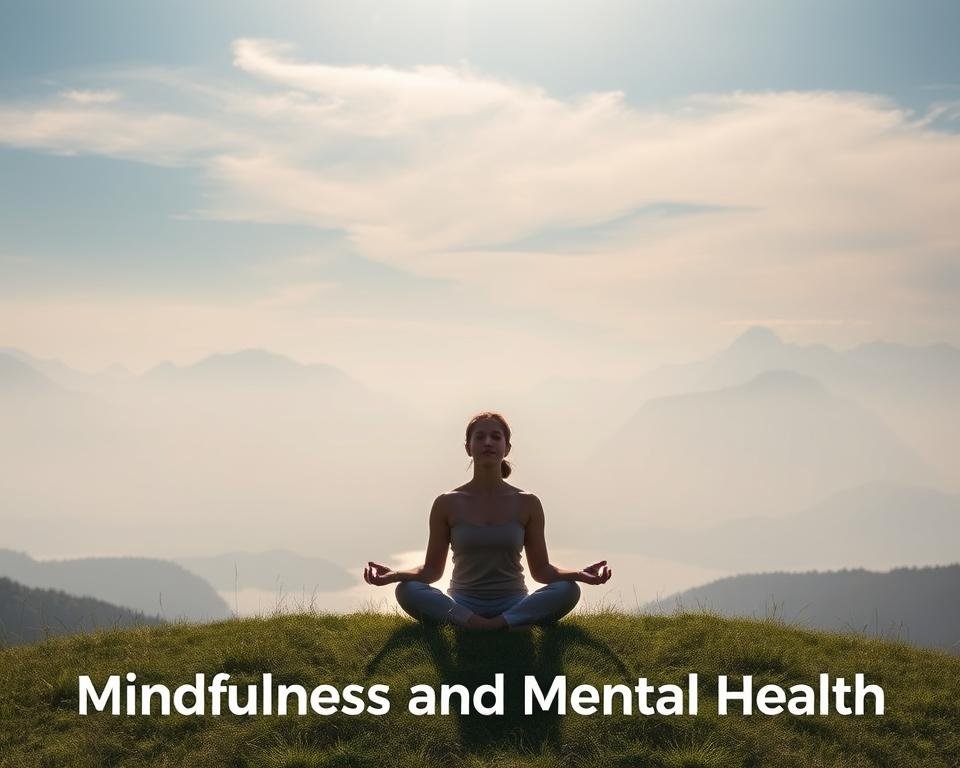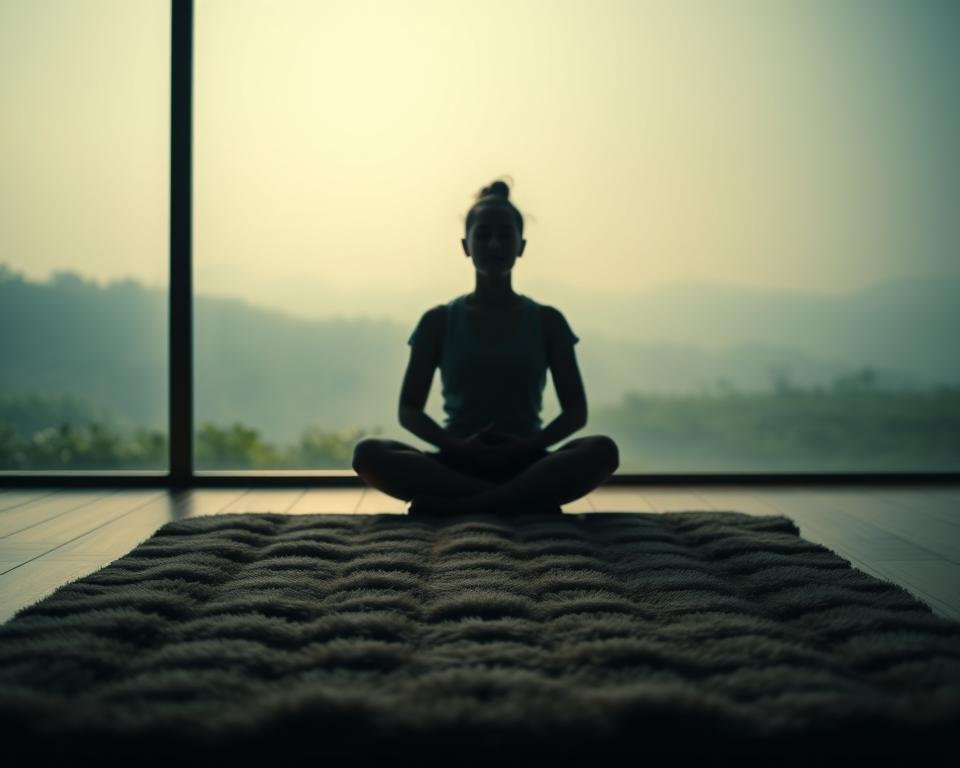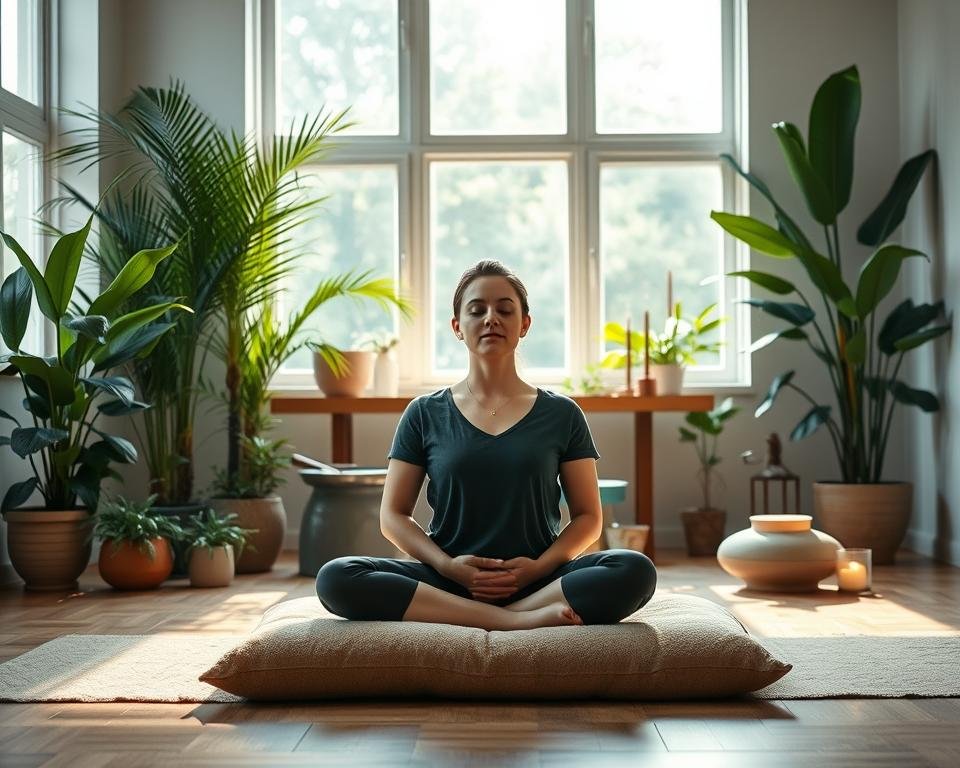Exploring mindfulness is exciting. I want to share key techniques that can change your life. In today’s fast world, it’s easy to lose sight of what’s important.
Mindfulness techniques help you find calm and focus. They make your daily life better by reducing stress and improving your mental health.
I’m here to show you the best techniques. They will help you live a more mindful and happy life.
Key Takeaways
- Reduce stress and anxiety with mindfulness techniques
- Improve mental health and well-being
- Enhance focus and clarity in daily life
- Cultivate a more mindful and fulfilling life
- Simple techniques to get you started on your mindfulness journey
What is Mindfulness?
In today’s fast world, mindfulness is key to better well-being. It helps us deal with stress and find balance in life.
Definition and Overview
Mindfulness means being fully present and aware of now. It’s about noticing thoughts, feelings, and body sensations without judgment. It uses meditation to increase awareness of our experiences.
Being mindful helps us stop living on autopilot. We start to think before acting. This makes us more real and connected to the world.
Benefits of Practicing Mindfulness
The benefits of mindfulness are many. It lowers stress and anxiety by teaching calm in tough times. It also boosts emotional control, focus, and overall happiness.
- Reduces stress and anxiety
- Improves emotional regulation
- Enhances focus and concentration
- Contributes to overall well-being
Adding mindfulness to our daily lives brings these benefits. It leads to a more balanced and fulfilling life. Mindfulness can change many parts of our lives for the better.
The Science Behind Mindfulness
Recent studies have shown how mindfulness changes our minds and brains. It’s an old practice but now science loves it for helping our mental health and stress.
Psychological Impact
Mindfulness greatly improves our mental health. It lowers anxiety and depression symptoms. It helps us handle our thoughts and feelings better.
It also cuts down stress. By staying in the now, we stop worrying about yesterday or tomorrow. This lowers our stress.

Neurological Changes
Neuroimaging shows mindfulness changes our brain. It makes areas for attention, emotions, and memory work better. These areas grow or get more active.
The hippocampus, key for learning and memory, gets bigger in those who practice mindfulness. This boosts our thinking and emotional strength.
Knowing how mindfulness changes our brain helps us see its value. It’s great for our mental health and stress relief.
Mindfulness Meditation Techniques
Meditation is a big part of mindfulness. It helps you feel more aware, clear, and calm. Adding these techniques to your day can lower stress and anxiety. It also helps with emotions and overall health.
Breath Awareness
Breath awareness is a top mindfulness practice. It means focusing on your breath and letting go of thoughts. Sit quietly, close your eyes, and watch your breath. Feel the air going in and out of your nose.

Body Scan Meditation
Body scan meditation is another strong mindfulness exercise. Lie down or sit comfortably. Start at your toes and move up to your head. Release any tension as you focus on each part.
Loving-Kindness Meditation
Loving-kindness meditation builds compassion and kindness. Start with yourself, saying “May I be happy, may I be healthy, may I be at peace.” Then, think of others, including those you might find hard to get along with. This practice helps you feel empathy and understanding.
Mindfulness in Everyday Life
Mindfulness isn’t just for sitting on a cushion. It’s a practice we can add to our daily lives. By doing this, we become more aware and appreciate the present moment.
Incorporating Mindfulness into Daily Routines
One easy way to practice mindfulness is by adding it to daily tasks. For example, while washing dishes, notice the water’s feel, the dishes’ weight, and the sound of suds. This turns a simple task into a meditation.
When walking, feel your feet on the ground, listen to your breath, and notice your surroundings. This keeps you present and focused.
Mindfulness can be done anywhere, anytime. It’s a great way to reduce stress and find joy.
Mindful Eating Practices
Mindful eating brings mindfulness into our daily lives. It’s about fully experiencing eating and drinking, both physically and emotionally.
- Savor each bite, noticing flavors, textures, and smells.
- Eat slowly, enjoying the taste and feel of food.
- Listen to your body’s hunger and fullness signals, eating when hungry and stopping when full.
By eating mindfully, we can have a better relationship with food and enjoy meals more.
Adding mindfulness to our daily routines and eating mindfully can greatly improve our well-being. It’s a journey that needs patience, consistency, and an open mind.
Mindfulness and Mental Health
Mindfulness has a big impact on mental health. It helps lower anxiety and stress. It also improves our emotional well-being.
Mindfulness is more than a practice. It’s a way of life that boosts our mental health. It helps us deal with life’s tough moments better.
Reducing Anxiety and Stress
Mindfulness is great for reducing anxiety and stress. It helps us stay in the present moment. This calms our minds and lessens stress.
- Mindful Breathing: Focusing on our breath calms the mind and lowers anxiety.
- Body Scan Meditation: This practice helps us relax by focusing on our body parts.

Enhancing Emotional Resilience
Mindfulness also boosts emotional resilience. It makes us more aware of our thoughts and feelings. This helps us handle tough situations better.
- Emotional Awareness: Mindfulness helps us understand our emotions. This way, we can respond wisely.
- Non-Judgmental Acceptance: Mindfulness teaches us to accept ourselves without judgment. This builds compassion for ourselves.
Adding mindfulness to our daily lives strengthens our emotional resilience. It prepares us to face life’s challenges head-on.
Mindfulness Exercises for Beginners
For those new to mindfulness, simple exercises can make all the difference. Mindfulness is about being present in the moment. It’s easier to achieve this state with guided exercises.
When starting out, it’s essential to begin with exercises that are both simple and effective. Two such exercises are beneficial for beginners: simple breathing exercises and walking meditation. These practices not only help in reducing stress but also improve overall well-being.
Simple Breathing Exercises
Simple breathing exercises are a foundational mindfulness practice. They involve focusing on your breath and letting go of distracting thoughts. To start, find a quiet spot, sit comfortably, and close your eyes.
Take slow, deep breaths, feeling the air fill your lungs and then release. If your mind wanders, gently bring your focus back to your breath.
This practice can be done anywhere, at any time. It’s a versatile tool for stress relief. Regular practice can lead to a calmer mind and improved emotional regulation.

Walking Meditation
Walking meditation is another accessible mindfulness exercise. It involves paying attention to your walking and the sensation of your feet touching the ground. To practice, choose a quiet path, stand for a moment, and then begin walking slowly.
Focus on the sensation of each step, and if your mind wanders, bring your attention back to the act of walking.
Walking meditation combines physical activity with mindfulness. It’s a great option for those who find it challenging to sit for long periods. It’s also a dynamic form of meditation.
By incorporating these simple mindfulness exercises into your daily routine, you can experience many benefits. These include reduced anxiety and improved focus. The key is consistency and patience, allowing yourself to fully embrace the practice.
Advanced Mindfulness Practices
Advanced mindfulness practices help deepen your journey. They boost self-awareness and emotional strength. Once you get the hang of basic techniques, try these more complex ones for better mental clarity and well-being.

Guided Visualizations
Guided visualizations use your imagination to relax and reduce stress. Imagine a peaceful place or a positive outcome. This calms your mind and focuses your thoughts.
Find a quiet spot, close your eyes, and listen to a guided recording. Or, imagine a calming scenario. Guided visualizations lower anxiety, improve focus, and boost creativity. They also help you stay positive and handle tough times better.
Mindful Journaling
Mindful journaling is writing down your thoughts and feelings. It helps you understand yourself better and grow in self-awareness. Start by setting aside time and space to write without judgment.
Mindful journaling improves emotional control, self-awareness, and understanding of your values and goals. It helps you be kinder and more reflective towards yourself.
Adding these advanced practices to your daily life brings more awareness, clarity, and happiness. Whether through guided visualizations or journaling, you’ll keep growing on your mindfulness path.
Mindfulness in the Workplace
Mindfulness is not just for personal use; it can change how we work together. It can make our jobs more satisfying and reduce stress. This is true for both individuals and teams.
Increasing Focus and Productivity
Mindfulness can make us more focused and productive at work. Simple activities like deep breathing or short meditation can fit into our busy days.
Some great mindfulness exercises for focus include:
- Mindful breathing: Focus on your breath to calm your mind.
- Body scan: Notice areas of tension and release them.
- Mindful walking: Pay attention to your steps and surroundings.
These can help us stay on track and avoid distractions.
Benefits of Mindfulness in the Workplace
| Benefit | Description |
|---|---|
| Increased Productivity | Mindfulness practices help employees stay focused and manage their workload more efficiently. |
| Improved Communication | Mindfulness enhances active listening and clarity in communication among colleagues. |
| Reduced Stress | Mindfulness techniques help reduce stress and anxiety, creating a healthier work environment. |
Building Better Work Relationships
Mindfulness is key in making work relationships stronger. It helps us listen better and understand each other more. This leads to better teamwork and communication.

To improve work relationships, try mindfulness activities that promote teamwork. Group meditation or workshops are great ways to start.
Mindfulness for Children and Teens
In today’s fast world, teaching mindfulness to kids is key. It helps them become more aware of themselves and their feelings. It also builds their ability to handle stress and emotions.
Mindfulness is a great tool for kids and teens. It helps them deal with life’s ups and downs. By learning mindfulness, they can better manage stress and stay focused.
Techniques for Young Minds
Mindfulness can be fun for kids and teens. Here are some cool ways to practice it:
- Guided meditations using stories or pictures
- Body scan exercises to relax
- Mindful movement like yoga or tai chi
- Breathing exercises to calm the mind
These methods can be adjusted for different ages. Young kids might enjoy games that teach mindfulness. Teens can try meditation and deep breathing.

Encouraging Mindful Habits
To help kids and teens be mindful, adults need to lead the way. Seeing grown-ups practice mindfulness encourages them to do the same.
Here are some tips to help them develop mindful habits:
- Start small: Begin with short exercises and grow them over time.
- Make it fun: Use games and activities that teach mindfulness.
- Be consistent: Set a regular time for mindfulness practice.
- Use technology: Try mindfulness apps made for kids and teens to make it fun.
Introducing mindfulness to young people helps them develop good habits. These habits can help them manage stress and improve their mental health as they grow.
For beginners, there are many resources out there. There are mindfulness for beginners guides and courses for both adults and kids.
Challenges in Practicing Mindfulness
Practicing mindfulness is rewarding but comes with obstacles. It’s key to know the common challenges we face.
Dealing with Distractions
Dealing with distractions is a big hurdle. It could be a busy mind, outside noise, or physical discomfort. These things make it hard to stay focused.
To beat this, creating a good environment is vital. This might mean finding a quiet spot or using earplugs or a white noise machine.
Another way is to acknowledge the distraction and then refocus on your meditation object, like your breath.
Effective Strategies for Minimizing Distractions:
- Identify a quiet, comfortable space for practice
- Use tools to minimize external noise
- Gently refocus attention when the mind wanders
Overcoming Self-Judgment
Self-judgment is another big challenge. It’s easy to judge ourselves or get frustrated when our minds wander.
The trick is to practice mindfulness without judgment. Remember, the goal is the practice itself, not reaching a certain state.
| Challenge | Strategy |
|---|---|
| Distractions | Create a conducive environment, gently refocus attention |
| Self-Judgment | Adopt a non-judgmental attitude, focus on the practice |
By knowing these challenges and using strategies to overcome them, we can grow in our mindfulness practice. This way, we can enjoy its many benefits.
Resources for Continued Learning
As you keep going on your mindfulness path, the right tools can really help. They can make your practice deeper and bring out the mindfulness benefits. It’s key to find various resources for your mental health and well-being.
Recommended Resources
There are many books, apps, online courses, and workshops for mindfulness. Apps like Headspace and Calm have guided meditations. Books like “The Miracle of Mindfulness” by Thich Nhat Hanh share mindfulness insights.
Online places like Coursera and Udemy have lots of mindfulness and mental health courses. Using these resources can improve your mindfulness and mental health. It can also make your life more mindful and fulfilling. Whether you’re new or experienced, there’s always more to learn and try.
FAQ
What is the best way to start a mindfulness practice?
Start with simple breathing exercises or guided meditations. Add mindfulness to your daily routine. Try it right after waking up or before bed.
How can mindfulness help with stress relief?
Mindfulness teaches you to focus on now, not past or future worries. It promotes calm and relaxation.
Can mindfulness be practiced by anyone?
Yes, anyone can practice mindfulness. It doesn’t matter your age, background, or experience level. It can be tailored to fit your needs and goals.
How long does it take to see the benefits of mindfulness?
You can feel the benefits in just a few minutes a day. But, regular practice leads to deeper and lasting changes.
Are there any mindfulness apps that you recommend?
Yes, check out Headspace, Calm, and Insight Timer. They offer guided meditations, tracking, and more to help your practice.
Can mindfulness be used in conjunction with other mental health treatments?
Yes, mindfulness can boost the effects of therapy or medication. It helps improve overall well-being.
How can I incorporate mindfulness into my daily routine?
Practice mindfulness in daily activities like eating, walking, or showering. Also, make time each day for dedicated mindfulness practice.
What are some common challenges in practicing mindfulness, and how can I overcome them?
Challenges include distractions, self-judgment, and staying motivated. Be patient, persistent, and kind to yourself. Seek help from mindfulness resources and communities.



